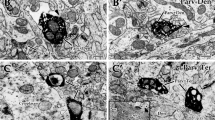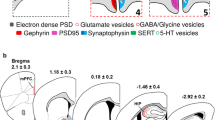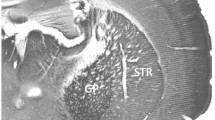Abstract
Purpose
The glutamatergic projection from the cerebral cortex and the thalamus extensively innervates the neostriatal neurons. However, some conflicts in the published literatures about cortical and thalamic intrastriatal synaptic terminals still need to be resolved. The present study intends to further elucidate the morphological characteristics of these two types of the terminals and their neurons.
Methods
The corticostriatal and thalamostriatal terminals were immunolabeled for vesicular glutamate transporter type 1 (VGluT1) and 2 (VGluT2), respectively, and their neurons were retrograde labeled by biotinylated dextran amine 3,000 molecular weight (BDA3k) injection into the dorsolateral striatum of rats. The characteristics of the corticostriatal and thalamostriatal terminals were observed at the LM and EM levels, and the data were statistically analyzed with SPSS10.0 software.
Results
We observed that 63.53% of VGluT1+ terminals synapsed on dendritic spines, which was different from VGluT2+ terminals with the equal percentage of synapses on spines and dendrites (14.88 and 17.86%, respectively). Notably, VGluT1+ axospinous synaptic terminals were remarkably larger than VGluT2+ axospinous synaptic terminals. Terminal size-frequency distribution analysis showed that VGluT1+ terminals were within the size ranges of 0.4–0.5 and 0.8–0.9 μm, and VGluT2+ terminals were in the ranges of 0.4–0.5 and 0.6–0.7 μm. Perforated-postsynaptic densities (-PSDs) were more frequently found in VGluT1+ axospinous synaptic terminals than in VGluT2+ axospinous terminals. Furthermore, BDA3k-labeled corticostrital neurons were larger in perikaryal diameter than the thalamostriatal neurons, and they were also categorized as the two main populations based on their size-frequency distribution.
Conclusions
The morphological characteristics of corticostriatal and thalamostriatal terminals and neurons have implications for understanding the roles of synaptic plasticity in adaptive motor control by the basal ganglia, and they have facilitations for understanding the complexities of basal ganglia function.






Similar content being viewed by others
References
Albin RL, Gilman S (1989) Parasagittal zonation of GABA-B receptors in molecular layer of rat cerebellum. Eur J Pharmacol 173(1):113–114
Calabresi P, Centonze D, Gubellini P, Marfia GA, Pisani A, Sancesario G, Bernardi G (2000) Synaptic transmission in the striatum: from plasticity to neurodegeneration. Prog Neurobiol 61(3):231–265
Dhanrajan TM, Lynch MA, Kelly A, Popov VI, Rusakov DA, Stewart MG (2004) Expression of long-term potentiation in aged rats involves perforated synapses but dendritic spine branching results from high-frequency stimulation alone. Hippocampus 14(2):255–264. doi:10.1002/hipo.10172
Ding J, Peterson JD, Surmeier DJ (2008) Corticostriatal and thalamostriatal synapses have distinctive properties. J Neurosci 28(25):6483–6492. doi:10.1523/JNEUROSCI.0435-08.2008
Dube L, Smith AD, Bolam JP (1988) Identification of synaptic terminals of thalamic or cortical origin in contact with distinct medium-size spiny neurons in the rat neostriatum. J Comp Neurol 267(4):455–471. doi:10.1002/cne.902670402
Fujiyama F, Unzai T, Nakamura K, Nomura S, Kaneko T (2006) Difference in organization of corticostriatal and thalamostriatal synapses between patch and matrix compartments of rat neostriatum. Eur J Neurosci 24(10):2813–2824. doi:10.1111/j.1460-9568.2006.05177.x
Gerfen CR (1992) The neostriatal mosaic: multiple levels of compartmental organization. J Neural Transm Suppl 36:43–59
Gerfen CR (1992) The neostriatal mosaic: multiple levels of compartmental organization in the basal ganglia. Annu Rev Neurosci 15:285–320. doi:10.1146/annurev.ne.15.030192.001441
Green A, Peters TJ, Webster DJ (1991) An assessment of academic performance and personality. Med Educ 25(4):343–348
Haber S, McFarland NR (2001) The place of the thalamus in frontal cortical-basal ganglia circuits. Neuroscientist 7(4):315–324
Hisano S, Hoshi K, Ikeda Y, Maruyama D, Kanemoto M, Ichijo H, Kojima I, Takeda J, Nogami H (2000) Regional expression of a gene encoding a neuron-specific Na(+)-dependent inorganic phosphate cotransporter (DNPI) in the rat forebrain. Brain Res Mol Brain Res 83(1–2):34–43
Ichinohe N, Iwatsuki H, Shoumura K (2001) Intrastriatal targets of projection fibers from the central lateral nucleus of the rat thalamus. Neurosci Lett 302(2–3):105–108
Johnston JG, Gerfen CR, Haber SN, van der Kooy D (1990) Mechanisms of striatal pattern formation: conservation of mammalian compartmentalization. Brain Res Dev Brain Res 57(1):93–102
Kopec C, Malinow R (2006) Neuroscience. Matters of size. Science 314(5805):1554–1555. doi:10.1126/science.1137595
Koshimizu Y, Wu SX, Unzai T, Hioki H, Sonomura T, Nakamura KC, Fujiyama F, Kaneko T (2008) Paucity of enkephalin production in neostriatal striosomal neurons: analysis with preproenkephalin-green fluorescent protein transgenic mice. Eur J Neurosci 28(10):2053–2064. doi:10.1111/j.1460-9568.2008.06502.x
Lapper SR, Bolam JP (1992) Input from the frontal cortex and the parafascicular nucleus to cholinergic interneurons in the dorsal striatum of the rat. Neuroscience 51(3):533–545
Lei W, Jiao Y, Del Mar N, Reiner A (2004) Evidence for differential cortical input to direct pathway versus indirect pathway striatal projection neurons in rats. J Neurosci 24(38):8289–8299
Matsumoto N, Minamimoto T, Graybiel AM, Kimura M (2001) Neurons in the thalamic CM-Pf complex supply striatal neurons with information about behaviorally significant sensory events. J Neurophysiol 85(2):960–976
Matsuzaki M (2007) Factors critical for the plasticity of dendritic spines and memory storage. Neurosci Res 57(1):1–9. doi:10.1016/j.neures.2006.09.017
McGuire PK, Bates JF, Goldman-Rakic PS (1991) Interhemispheric integration: II. Symmetry and convergence of the corticostriatal projections of the left and the right principal sulcus (PS) and the left and the right supplementary motor area (SMA) of the rhesus monkey. Cereb Cortex 1(5):408–417
Nicholson DA, Yoshida R, Berry RW, Gallagher M, Geinisman Y (2004) Reduction in size of perforated postsynaptic densities in hippocampal axospinous synapses and age-related spatial learning impairments. J Neurosci 24(35):7648–7653
Ragsdale CW Jr, Graybiel AM (1991) Compartmental organization of the thalamostriatal connection in the cat. J Comp Neurol 311(1):134–167. doi:10.1002/cne.903110110
Raju DV, Shah DJ, Wright TM, Hall RA, Smith Y (2006) Differential synaptology of vGluT2-containing thalamostriatal afferents between the patch and matrix compartments in rats. J Comp Neurol 499(2):231–243. doi:10.1002/cne.21099
Reiner A, Anderson KD (1990) The patterns of neurotransmitter and neuropeptide co-occurrence among striatal projection neurons: conclusions based on recent findings. Brain Res Brain Res Rev 15(3):251–265
Reiner A, Jiao Y, Del Mar N, Laverghetta AV, Lei WL (2003) Differential morphology of pyramidal tract-type and intratelencephalically projecting-type corticostriatal neurons and their intrastriatal terminals in rats. J Comp Neurol 457(4):420–440. doi:10.1002/cne.10541
Smith Y, Raju DV, Pare JF, Sidibe M (2004) The thalamostriatal system: a highly specific network of the basal ganglia circuitry. Trends Neurosci 27(9):520–527
Tsvetkov E, Carlezon WA, Benes FM, Kandel ER, Bolshakov VY (2002) Fear conditioning occludes LTP-induced presynaptic enhancement of synaptic transmission in the cortical pathway to the lateral amygdala. Neuron 34(2):289–300
Van der Werf YD, Witter MP, Groenewegen HJ (2002) The intralaminar and midline nuclei of the thalamus. Anatomical and functional evidence for participation in processes of arousal and awareness. Brain Res Brain Res Rev 39(2–3):107–140
Acknowledgments
This study was supported by the grants from the National Science Foundations of China (No. 31070941, No. 20831006, No. 30770679) and the Major State Basic Research Development Program of China (973 Program) (No. 2010CB530004).
Conflict of interest
The authors declare that they have no conflict of interest.
Author information
Authors and Affiliations
Corresponding author
Rights and permissions
About this article
Cite this article
Liu, B., Ouyang, L., Mu, S. et al. The morphological characteristics of corticostriatal and thalamostriatal neurons and their intrastriatal terminals in rats. Surg Radiol Anat 33, 807–817 (2011). https://doi.org/10.1007/s00276-011-0823-9
Received:
Accepted:
Published:
Issue Date:
DOI: https://doi.org/10.1007/s00276-011-0823-9




